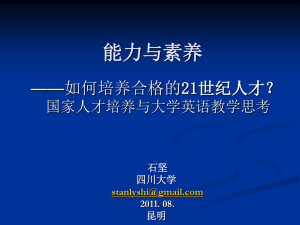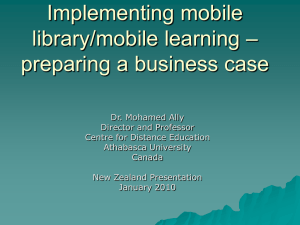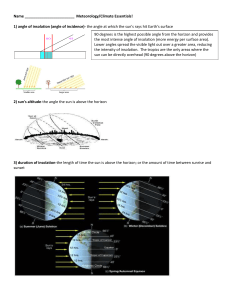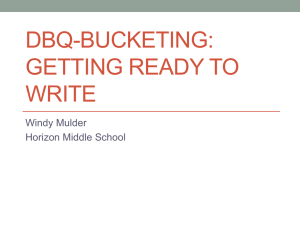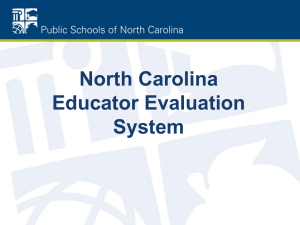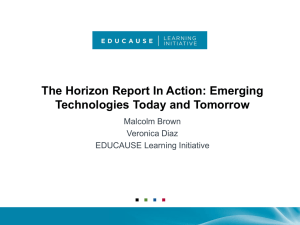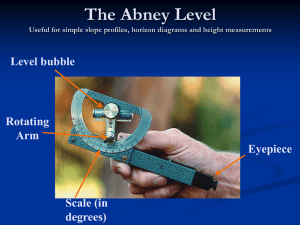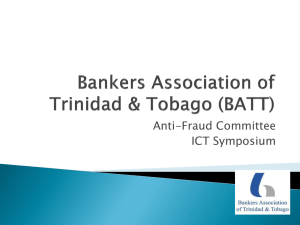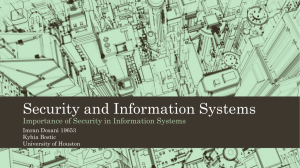Powerpoint
advertisement
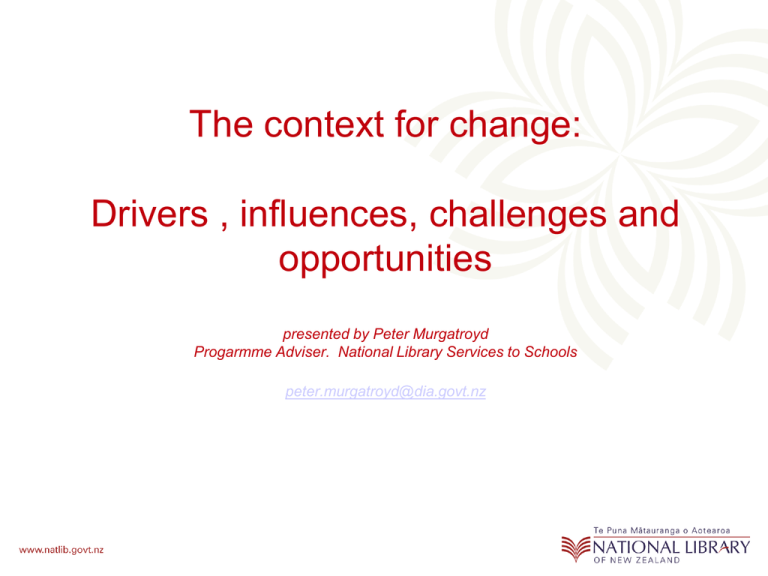
The context for change: Drivers , influences, challenges and opportunities presented by Peter Murgatroyd Progarmme Adviser. National Library Services to Schools peter.murgatroyd@dia.govt.nz Societal transformation We live in a world with an unprecedented degree of complexity, fluidity and uncertainty … “We are currently preparing students for jobs that don’t yet exist . . . using technologies that haven’t yet been invented . . . in order to solve problems we don’t even know are problems yet” —Richard Riley, Secretary of Education under Clinton A paradigm shift in educational thinking Understanding the context of change • The uniqueness of each school’s local context makes change a complex and subtle process • One size does not fit all • Ecosystem approach • Driven by student learning outcomes • Critical importance of school culture and leadership • Connections and collaboration across institutional boundaries Institutional culture / personal mindset • Fearless innovation • Comfort with ambiguity • Embracing disruption • Reflective practice If you don't know where you are going, any road will get you there. – Lewis Carroll 21st century schools Supporting future-oriented learning and teaching - a New Zealand perspective http://www.educationcounts.govt.nz/publications/schooling/109306 • Personalising learning • New views of equity, diversity and inclusivity • A curriculum that uses knowledge to develop learning capacity • “Changing the script”: Rethinking learners’ and teachers’ roles • A culture of continuous learning for teachers and educational leaders • New kinds of partnerships and relationships: Schools no longer siloed from the community Sub themes • New technologies - the rapid development and ubiquity of ICT are resetting the boundaries of educational possibilities • Collaborative practices - educational clustering , networking and partnerships between institutions provide opportunities for expanding ideas about what is possible Priority Learners Government Priority - “that by 2017, 85% of all 18 year olds in New Zealand will have NCEA Level 2 or its equivalent” E-Learning and ICT • Shifts in pedagogy • Collaborative learning • Gaming and mobile technology • Multiliteracies NMC Horizon Report 2013 K-12 edition: emerging technologies likely to have a large impact over the coming five years in education • Near-term horizon Cloud computing Mobile learning • Mid-term horizon Learning analytics Open content • Far-term horizon 3D printing Virtual and remote laboratories Key trends • Education paradigms are shifting to include online learning, hybrid learning, and collaborative models. • Social media is changing the way people interact, present ideas and information, and communicate. • Openness — concepts like open content, open data, and open resources, along with notions of transparency and easy access to data and information — is becoming a value. • As the cost of technology drops and school districts revise and open up their access policies, it is becoming more common for students to bring their own mobile devices. • The abundance of resources and relationships made easily accessible via the Internet is challenging us to revisit our roles as educators. Core-Eds Ten Trends http://www.core-ed.org/sites/core-ed.org/files/Ten-Trends-Matrix-2013-v1.pdf • Personalisation • Thinking 3D • User + Control • Citizenship • The Smart Web • Social Learning • Virtual Learning • Ubiquity • Data Engagement • Open-ness Social and Virtual Learning • Making content , resources and expertise available through social channels • Engaging with students and supporting learning virtually providing access to resources and support those who may not otherwise be able to participate – Virtual schools and expansion of formal and informal learning opportunities online Ubiquitous Learning • Is about learning anywhere, at anytime, using any device. It is being driven by the convergence in cloud computing, online services and mobile devices Open-ness • Is a response to many of the aspects of our current system that may be described as closed, creating new ways of thinking about access to educational opportunities and resources, minimising barriers, and opening up opportunities for participation Inquiry into 21st century learning environments and digital literacy (2012) “The report acknowledges that the education sector is changing significantly as result of new technologies and access to the internet. This report concludes that significant change is required across government if our learners and teachers are to take full advantage of the digital learning resources available to them.” Recommendations: • That it investigate the benefits and implications, along with any policy or legislative changes, of extending availability of school facilities and resources, including computer labs and Internet connections, to their communities • That it create best-practice design templates for school buildings so that newly-built schools and upgrades are more open, flexible, and networked. • That it consider how school libraries can be 21st century learning environments • That it consider encouraging local government to ensure greater Internet access via public libraries for out-of-school learning as a valuable community resource. • That it consider requiring all New Zealand teachers to demonstrate a defined standard of digital literacy and to undertake professional learning and development to maintain their digital literacy skills, knowledge, and understanding. Unbundling schools – Unbundling libraries • What happens to traditional concepts of classrooms and teaching when we can now learn anything, anywhere, anytime? • What happens to traditional concepts of library when access to information is ubiquitous? • Is there a need to deconstruct established structures and routines and reassemble them in newer, smarter ways to better reflect the context and demands of the 21st century world? Discussion • What do you see as the biggest influences that will shape future school library services? • What are the greatest threats / challenges? • Where are the greatest opportunities? Images Shift key Image by C Slack http://www.flickr.com/photos/slackpics/4261060942/ Ubiquitous Learning Image by by ~aurorasognatrice http://aurorasognatrice.deviantart.com/art/Mac-OS-X-Tardis-Wallpaper-I-186682811 Open-ness Image by Yann Forget http://commons.wikimedia.org/wiki/File:Juggling_on_the_Berlin_Wall.jpg Social learning Image by Matt Hamm http://www.flickr.com/photos/matthamm/2945559128/ MLE matrix Core-Eds MLE matrix - http://www.core-ed.org/professional-learning/mle-matrix Institutional culture Image by Cog Log Lab http://www.flickr.com/photos/cogloglab/4091785597

